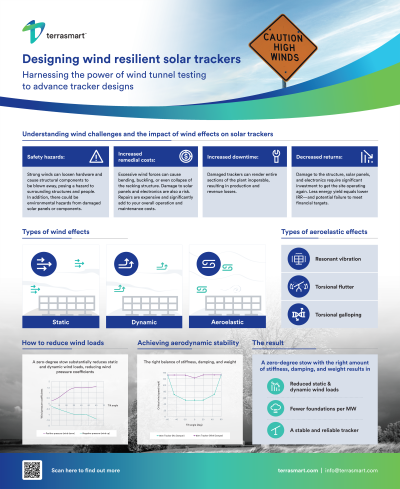Back

Finance and Asset Management
Driving Value for PV Through the Forces of Wind
Tuesday, September 12, 2023
4:30 PM - 5:30 PM PDT
Location: Poster Area, Booth #11024, Level 1, Venetian Expo Hall


Chase Anderson (he/him/his)
Director of Product Development
Terrasmart
Fort Myers, Florida, United States
Poster Presenter(s)
Rolling hills, rocky soils, and wicked weather - all of these challenges affect a solar plant’s profitability. But none impact levelized cost of energy (LCOE) as much as wind.
Rather than designing a single-axis tracker (SAT) that can perform while resisting wind, the presenter found a way to leverage the forces of the wind to its advantage – essentially turning the traditional product design process upside down.
This presentation showcases a novel approach to new product design. EPCs, developers, plant owners and operators will walk away with a deeper understanding of the schedule and cost advantages of 1P SAT configuration, its performance and reliability against wind forces, and its advantages across terrain and ground challenges, resulting in even more value and lower LCOE for utility solar PV.
Market dynamics set the stage
According to the latest market data from SEIA, the U.S. is optimistic for a rebound in 2023 regarding solar installations after module tariffs, circumvention petitions, and forced labor prevention measures lead to module shortages and project delays. In its latest U.S. Solar Market Insight, the utility sector had 10 GW of new projects contracted in Q2 2022, representing the highest quarterly total since 2019.
And while the Inflation Reduction Act will bring certainty and supply stability, domestic material sourcing requirements might drive up material costs. Data reported in Q1 2022 shows pricing for utility SAT systems increased by 6% year-over-year, with a national average price of $1.01/Wp for the segment.
In today’s razor-thin margin market, every cent saved in a system’s LCOE translates into competitive advantages and profitability for all of the stakeholders involved in the project’s lifecycle.
SAT configurations: Pro’s & Con’s of 1P vs 2P
1P trackers that support modules vertically equire mostly flat terrains due to their length. In terms of assembly, 1P’s lower tracker height allows for a more ergonomic installation. 2P trackers that have a vertical two-panel configuration are shorter in length, making them more adaptable to terrain and require fewer foundations. While EPCs appreciate these construction advantages, the increased height of the 2P makes this design more susceptible to wind-related events that can erode LCOE targets.
To mitigate wind forces, 2P trackers require deeper foundations.
Innovative approach to product design
Over the past decades, component manufacturers have traditionally met performance targets by designing their hardware to meet environmental and site conditions.
Today’s innovative OEMs are looking at new ways to design for enhanced performance and profitability to drive even more value out of their products.
Terrasmart is taking is taking a novel approach to how it designs its new single-axis tracker: instead of designing their racking to handle tough terrain and wicked weather, this domestic supplier has adopted a new strategy to drive innovation. Rather than designing a SAT that can perform while resisting the wind, it found a way to leverage the forces of the wind to its advantage – essentially turning the traditional design process upside down.
The design team used wind tunnel testing differently – it didn’t use it to test failure points but rather to drive design advancements. Over 200 hours of wind tunnel tests (25 percent more than average) with leading third party laboratories led to multiple designs and layouts.
Unique advantages of wind-optimized 1P design
Wind-optimization resulted in a 1P system able to sustain winds up to 105 mph. A zero-degree stow greatly reduces static and dynamic wind loads allowing for fewer foundations and less materials. This lowers capex costs related to materials and installation. Added dampers and shorter row lengths keep systems safe against aero-elastic wind. It also allows for a zero-degree stow strategy, which keeps systems safe while maximizing energy production. Other advantages include:
73% reduction in bushing assembly parts
Streamlined wire management for easier electrical installation
Rather than designing a single-axis tracker (SAT) that can perform while resisting wind, the presenter found a way to leverage the forces of the wind to its advantage – essentially turning the traditional product design process upside down.
This presentation showcases a novel approach to new product design. EPCs, developers, plant owners and operators will walk away with a deeper understanding of the schedule and cost advantages of 1P SAT configuration, its performance and reliability against wind forces, and its advantages across terrain and ground challenges, resulting in even more value and lower LCOE for utility solar PV.
Market dynamics set the stage
According to the latest market data from SEIA, the U.S. is optimistic for a rebound in 2023 regarding solar installations after module tariffs, circumvention petitions, and forced labor prevention measures lead to module shortages and project delays. In its latest U.S. Solar Market Insight, the utility sector had 10 GW of new projects contracted in Q2 2022, representing the highest quarterly total since 2019.
And while the Inflation Reduction Act will bring certainty and supply stability, domestic material sourcing requirements might drive up material costs. Data reported in Q1 2022 shows pricing for utility SAT systems increased by 6% year-over-year, with a national average price of $1.01/Wp for the segment.
In today’s razor-thin margin market, every cent saved in a system’s LCOE translates into competitive advantages and profitability for all of the stakeholders involved in the project’s lifecycle.
SAT configurations: Pro’s & Con’s of 1P vs 2P
1P trackers that support modules vertically equire mostly flat terrains due to their length. In terms of assembly, 1P’s lower tracker height allows for a more ergonomic installation. 2P trackers that have a vertical two-panel configuration are shorter in length, making them more adaptable to terrain and require fewer foundations. While EPCs appreciate these construction advantages, the increased height of the 2P makes this design more susceptible to wind-related events that can erode LCOE targets.
To mitigate wind forces, 2P trackers require deeper foundations.
Innovative approach to product design
Over the past decades, component manufacturers have traditionally met performance targets by designing their hardware to meet environmental and site conditions.
Today’s innovative OEMs are looking at new ways to design for enhanced performance and profitability to drive even more value out of their products.
Terrasmart is taking is taking a novel approach to how it designs its new single-axis tracker: instead of designing their racking to handle tough terrain and wicked weather, this domestic supplier has adopted a new strategy to drive innovation. Rather than designing a SAT that can perform while resisting the wind, it found a way to leverage the forces of the wind to its advantage – essentially turning the traditional design process upside down.
The design team used wind tunnel testing differently – it didn’t use it to test failure points but rather to drive design advancements. Over 200 hours of wind tunnel tests (25 percent more than average) with leading third party laboratories led to multiple designs and layouts.
Unique advantages of wind-optimized 1P design
Wind-optimization resulted in a 1P system able to sustain winds up to 105 mph. A zero-degree stow greatly reduces static and dynamic wind loads allowing for fewer foundations and less materials. This lowers capex costs related to materials and installation. Added dampers and shorter row lengths keep systems safe against aero-elastic wind. It also allows for a zero-degree stow strategy, which keeps systems safe while maximizing energy production. Other advantages include:
73% reduction in bushing assembly parts
Streamlined wire management for easier electrical installation
